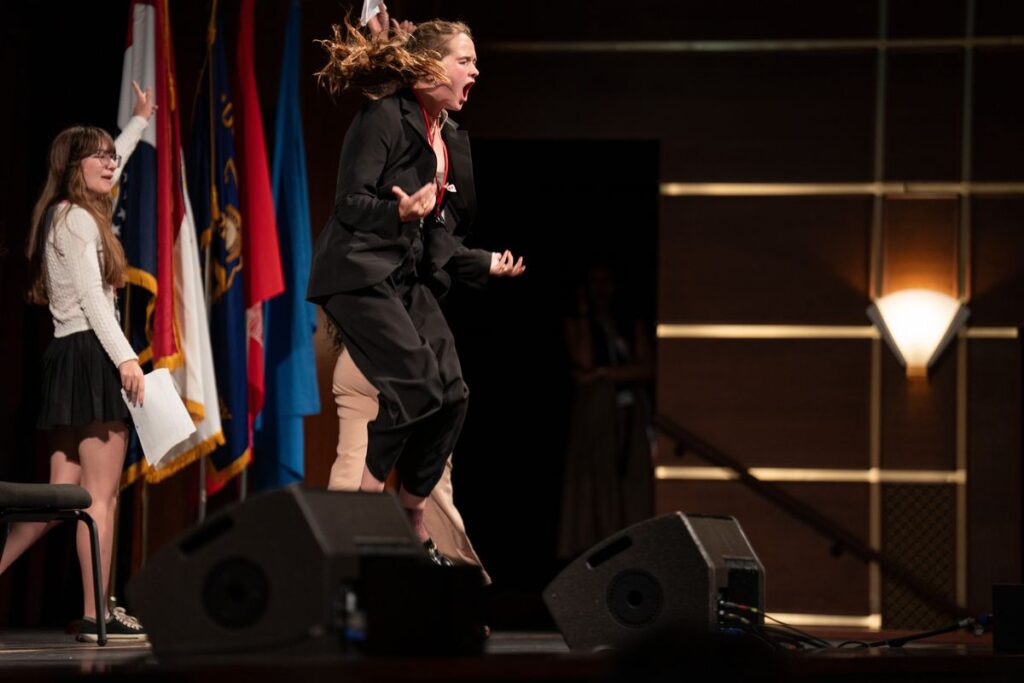Back in 2020, filmmaking partners Amanda McBaine and Jesse Moss released Boys State, a startling, compulsively watchable documentary that packs all of America’s political flaws into one competitive event. Embedding themselves in the 2018 Texas edition of Boys State, an annual leadership event where a thousand teenage boys are brought together to form a mock U.S. government, McBaine and Moss tracked a handful of participants as they vied for public office, learned terrible lessons about American politics, and alternated between acting like jaded statesmen and acting like teenage boys. One of the most obvious questions coming out of that documentary was: What does the girls’ version of this same event look like?
The filmmakers have answered that question on Apple TV Plus with Girls State, a structurally similar documentary made during the 2022 Missouri edition of the affiliated event for teenage girls. As it turns out, audiences and the filmmakers aren’t the only ones who wondered how the Boys State and Girls State experiences might differ: Over the course of shooting, one of Girls State’s central subjects, Emily Worthmore, launches an investigation into inequalities in the programs’ funding, rules, and focus, and digs up some unsurprising truths. Between those revelations and the exact point in 2022 when the documentary was shot, Girls State is perfectly aligned to be infuriating — and just as telling as Boys State was about the state of America.
Worthmore is one of a small handful of subjects the documentarians stick to, as she lays out her expectations for the program (and her ambitious future political career), enters the event, runs for office, faces disappointment, then launches her investigation into how the boys’ and girls’ programs compare. The downsizing of Worthmore’s ambitions is sobering: Her conviction at the beginning of the movie that she’ll be running for president of the United States by 2040 crumbles over the course of just one week of Girls State.
Much as with Boys State, there’s a sense throughout the documentary that the profiled individuals’ experiences reflect similar stories from hundreds of participants, each of whom might have made an equally compelling (or even more compelling) focal character. There’s a lot going on at this event, as so many ambitious, precocious young activists report that they were satisfyingly successful and central in their own hometown student governments — then have to face, for the first time, the idea that they might not seem nearly as exceptional or noteworthy once they enter a larger pond. At the same time, many of them seem to be encountering people with different political beliefs for the first time. And while they all announce their intention to hear the opposition out without malice and really dig into the issues, the filmmakers keep capturing them talking over each other or tuning each other out.
But the more mesmerizing and saddening thread running through Girls State comes from its timing: The event happened in the window between the leak revealing the Supreme Court’s intention to overturn Roe v. Wade and the actual ruling being released. Over and over, the filmmakers capture Girls State participants confidently stating that the Court wouldn’t actually take such an extreme action — including during an event where Girls State’s own all-teenage-girl Supreme Court soberly rules on whether women should be legally forced into counseling before being permitted to have an abortion.
Photo: Apple TV Plus
By comparison with the newer doc, Boys State feels far more internal and self-focused. The central subjects in that documentary similarly lose some of their naiveté and optimism about American politics, but it’s solely because of interactions with each other and their own political system. By contrast, the subjects of Girls State are trying to express their confidence about their power and impact in the world, while simultaneously watching their country deny them rights over their own bodies and emphasize their powerlessness. There’s a particularly uncomfortable irony in watching them working to piece together their own political beliefs and futures while their government is shutting down their options.
While that isn’t the primary focus here, the movie is still riddled with queasy interplay between the intended empowerment of this youth-culture political playground and the enervation of real-world politics and sexism, including the facts Worthmore digs up about Girls State funding and rules. And there’s a similarly engaging, thought-provoking interplay between the different social pressures these girls feel — to compete with each other yet support each other, to be forceful yet polite, decisive yet open-minded. The central subjects are smart and self-aware enough to see how those pressures conflict, and to discuss and debate them.
That alone keeps Girls State from being depressing. It’s fascinating, rather, to see how McBaine and Moss thread all the different stories together, and how they capture both the commonalities between the girls they highlight, and the differences between how they approach the event and what they take away from it. Like its companion piece, Girls State zooms in on what it feels like to be young, confident, and politically ambitious in America right now, and captures the kinds of pressures pushing the next generation toward either tuning out or taking action. Worthmore seems to come out of the project with new determination and purpose. Here’s hoping she isn’t alone.
Girls State is now streaming on Apple TV Plus.

